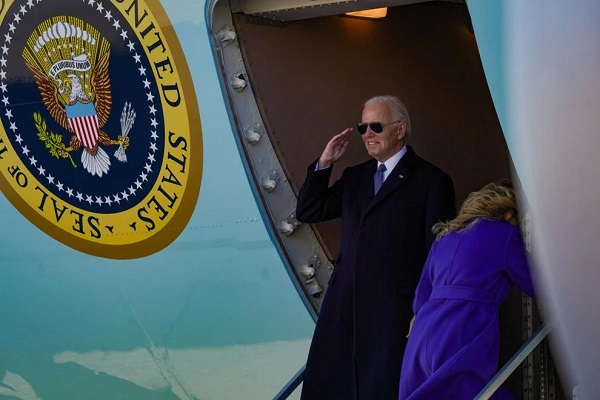Uncategorized
Deadly fire levelled a California town in less than a day

PARADISE, Calif. — Not a single resident of Paradise can be seen anywhere in town after most of them fled the burning Northern California community that may be lost forever. Abandoned, charred vehicles cluttered the main thoroughfare, evidence of the panicked evacuation a day earlier.
Most of its buildings are in ruin. Entire
Only a day after it began, the blaze that started outside the hilly town of Paradise had grown on Friday to nearly 140 square miles (360 square
Nine people have been found dead, some inside their cars and others outside vehicles or homes after a desperate evacuation that Butte County Sheriff Kory Honea called “the worst-case scenario.” Their identities were not yet known.
“It is what we feared for a long time,” Honea said, noting there was no time to knock on residents’ doors one-by-one.
With fires also burning in Southern California , state officials put the total number of people forced from their homes at more than 200,000. Evacuation orders included the entire city of Malibu, which is home to 13,000, among them some of Hollywood’s biggest stars.
President Donald Trump issued an emergency declaration providing federal funds for Butte, Ventura and Los Angeles counties.
The fire in Paradise, about 180 miles (290
A thick, yellow haze hung in the air, giving the appearance of twilight in the middle of the day. Some of the “majestic oaks” the town boasts of on its
Thursday morning’s evacuation order set off a desperate exodus in which many frantic motorists got stuck in gridlocked traffic. Many abandoned their vehicles to flee on foot as the flames bore down on all sides.
“The fire was so close I could feel it in my car through rolled up windows,” said Rita Miller, who fled Paradise with her disabled mother.
The town, situated on a ridge between two valleys, was a popular retirement community, raising concerns of elderly and immobile residents who have been reported missing.
On the outskirts of town, Patrick Knuthson, a fourth-generation resident, said only two of the 22 homes that once stood on his street are still there — his and a
“The fire burned from one house, to the next house, to the next house until they were pretty much all gone,” Knuthson said. He worked side-by-side with
“I lost my home in 2008, and it’s something you can’t really describe until you go through it,” said Knuthson, who battled flames eight feet or taller as strong winds whipped hot embers around him. He worked so long in the flames and smoke that he needed to use oxygen Thursday night at his home, but he refused to leave.
On Friday, Knuthson was covered from head to toe in black soot. His tiny town will never be the same, he said. The bucolic country landscape dotted with bay and oak trees will take years to recover.
In the town’s central shopping area, there was little left but rubble.
St. Nicolas Church still stands, a rare exception. The nearby New Life church is gone. An unblemished Burger King sign rises above a pile of charred rubble. The metal patio tables are the only recognizable things under Mama Celeste’s pizzeria sign. Only blackened debris remains behind the Happy Garden Chinese Restaurant sign touting its sushi. Seven burned out Mercedes chassis are all that’s left of Ernst Mercedes Specialist lot.
City Hall survived. But the Moose Lodge and Chamber of Commerce buildings didn’t.
The town’s 100-bed hospital is still standing, but two of its smaller buildings, including an outpatient clinic, are flattened. The Adventist Feather River Hospital evacuated its 60 patients in a frantic rush when the evacuation order came Thursday morning. Some were forced back by clogged roads, but all of them eventually made it out, some in dramatic fashion.
On the outskirts of Paradise, Krystin Harvey lost her mobile home. She described a town rich with historical charm, until a day ago.
“It was an old country town. It had the old buildings lined up along the walkway,” she said. “Almost all businesses were locally owned and included an assortment of antique shops, thrift stores, small restaurants, two bars and lots of churches.”
Harvey wondered if the town’s traditions would survive. The town was famous for the discovery of a 54-pound gold nugget in the 1800s, which eventually prompted a festival known as Gold Nugget Days. The highlight of the festival is a parade that features a Gold Nugget Queen.
“My daughter’s going out for the gold nugget queen this year,” said Harvey, then she paused. “Well, it’s been going for 100 years, but we don’t know — there’s no town now.”
People in Paradise, like so many in California, have become accustomed to wildfires, and many said they were well prepared. They kept their gutters clean, some kept pumps in their swimming pools and had fire hoses. But the ferocity and speed of this blaze overwhelmed those preparations.
Drought, warmer weather attributed to climate change and home construction deeper into forests have led to more destructive wildfire seasons that have been starting earlier and lasting longer.
Just 100 miles north of Paradise, the sixth most destructive wildfire in California history hit in July and August and was also one of the earliest. Called the Carr Fire, near Redding, it killed eight people, burned about 1,100 homes and consumed 358 square miles (927 square
Paradise town Councilmember Melissa Schuster lost her 16-acre Chapelle de L’Artiste retreat, a posh property with a chapel, pond and pool. But Friday she was clinging to two furry glimmers of hope: Shyann and Twinkle Star Heart.
“Our llamas,” she said. “Somehow they made it through.”
Schuster said they stopped trying to hook up a trailer for the animals and fled their home and property with just their three cats on Thursday when the day turned pitch black as fire roared in.
“It’s Paradise,” she said. “It’s always been Paradise, and we will bring it back.”
___
Associated Press writers Don Thompson in Chico and Jocelyn Gecker, Janie Har, Martha Mendoza, Daisy Nguyen, Olga R. Rodriguez and Sudhin Thanawala in San Francisco contributed to this report.
Paul Elias And Gillian Flaccus, The Associated Press
Uncategorized
Kananaskis G7 meeting the right setting for U.S. and Canada to reassert energy ties


Energy security, resilience and affordability have long been protected by a continentally integrated energy sector.
The G7 summit in Kananaskis, Alberta, offers a key platform to reassert how North American energy cooperation has made the U.S. and Canada stronger, according to a joint statement from The Heritage Foundation, the foremost American conservative think tank, and MEI, a pan-Canadian research and educational policy organization.
“Energy cooperation between Canada, Mexico and the United States is vital for the Western World’s energy security,” says Diana Furchtgott-Roth, director of the Center for Energy, Climate and Environment and the Herbert and Joyce Morgan Fellow at the Heritage Foundation, and one of America’s most prominent energy experts. “Both President Trump and Prime Minister Carney share energy as a key priority for their respective administrations.
She added, “The G7 should embrace energy abundance by cooperating and committing to a rapid expansion of energy infrastructure. Members should commit to streamlined permitting, including a one-stop shop permitting and environmental review process, to unleash the capital investment necessary to make energy abundance a reality.”
North America’s energy industry is continentally integrated, benefitting from a blend of U.S. light crude oil and Mexican and Canadian heavy crude oil that keeps the continent’s refineries running smoothly.
Each day, Canada exports 2.8 million barrels of oil to the United States.
These get refined into gasoline, diesel and other higher value-added products that furnish the U.S. market with reliable and affordable energy, as well as exported to other countries, including some 780,000 barrels per day of finished products that get exported to Canada and 1.08 million barrels per day to Mexico.
A similar situation occurs with natural gas, where Canada ships 8.7 billion cubic feet of natural gas per day to the United States through a continental network of pipelines.
This gets consumed by U.S. households, as well as transformed into liquefied natural gas products, of which the United States exports 11.5 billion cubic feet per day, mostly from ports in Louisiana, Texas and Maryland.
“The abundance and complementarity of Canada and the United States’ energy resources have made both nations more prosperous and more secure in their supply,” says Daniel Dufort, president and CEO of the MEI. “Both countries stand to reduce dependence on Chinese and Russian energy by expanding their pipeline networks – the United States to the East and Canada to the West – to supply their European and Asian allies in an increasingly turbulent world.”
Under this scenario, Europe would buy more high-value light oil from the U.S., whose domestic needs would be back-stopped by lower-priced heavy oil imports from Canada, whereas Asia would consume more LNG from Canada, diminishing China and Russia’s economic and strategic leverage over it.
* * *
The MEI is an independent public policy think tank with offices in Montreal, Ottawa, and Calgary. Through its publications, media appearances, and advisory services to policymakers, the MEI stimulates public policy debate and reforms based on sound economics and entrepreneurship.
As the nation’s largest, most broadly supported conservative research and educational institution, The Heritage Foundation has been leading the American conservative movement since our founding in 1973. The Heritage Foundation reaches more than 10 million members, advocates, and concerned Americans every day with information on critical issues facing America.
Uncategorized
Poilievre on 2025 Election Interference – Carney sill hasn’t fired Liberal MP in Chinese election interference scandal

From Conservative Party Communications
“Yes. He must be disqualified. I find it incredible that Mark Carney would allow someone to run for his party that called for a Canadian citizen to be handed over to a foreign government on a bounty, a foreign government that would almost certainly execute that Canadian citizen.
“Think about that for a second. We have a Liberal MP saying that a Canadian citizen should be handed over to a foreign dictatorship to get a bounty so that that citizen could be murdered. And Mark Carney says he should stay on as a candidate. What does that say about whether Mark Carney would protect Canadians?
“Mark Carney is deeply conflicted. Just in November, he went to Beijing and secured a quarter-billion-dollar loan for his company from a state-owned Chinese bank. He’s deeply compromised, and he will never stand up for Canada against any foreign regime. It is another reason why Mr. Carney must show us all his assets, all the money he owes, all the money that his companies owe to foreign hostile regimes. And this story might not be entirely the story of the bounty, and a Liberal MP calling for a Canadian to be handed over for execution to a foreign government might not be something that the everyday Canadian can relate to because it’s so outrageous. But I ask you this, if Mark Carney would allow his Liberal MP to make a comment like this, when would he ever protect Canada or Canadians against foreign hostility?
“He has never put Canada first, and that’s why we cannot have a fourth Liberal term. After the Lost Liberal Decade, our country is a playground for foreign interference. Our economy is weaker than ever before. Our people more divided. We need a change to put Canada first with a new government that will stand up for the security and economy of our citizens and take back control of our destiny. Let’s bring it home.”
-

 Alberta1 day ago
Alberta1 day agoCentral Alberta MP resigns to give Conservative leader Pierre Poilievre a chance to regain a seat in Parliament
-

 Alberta21 hours ago
Alberta21 hours agoUnified message for Ottawa: Premier Danielle Smith and Premier Scott Moe call for change to federal policies
-

 Alberta1 day ago
Alberta1 day agoAlberta pro-life group says health officials admit many babies are left to die after failed abortions
-

 Business20 hours ago
Business20 hours agoCanada’s critical minerals are key to negotiating with Trump
-

 International13 hours ago
International13 hours agoJudiciary explores accountability options over Biden decline ‘coverup’
-

 Alberta1 day ago
Alberta1 day agoCalls for a new pipeline to the coast are only getting louder
-

 Business13 hours ago
Business13 hours agoRFK Jr. planning new restrictions on drug advertising: report
-

 Education1 day ago
Education1 day agoStudents can’t use AI to cheat on standardized tests






